piano
Pierné - Pièce - Alto Flute & Piano
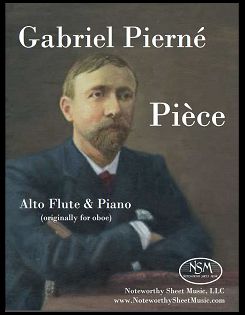 Pièce, Op.5, by Gabriel Pierné
Pièce, Op.5, by Gabriel Pierné
Transcribed for Alto Flute and Piano by Carol A. Vater
Piano Score and Alto Flute Part, PDF $6.99
The Pièce en sol mineur for oboe (or violin or cello) with accompaniment of piano was composed by Gabriel Pierné in 1883. The alto flute is especially well-suited to this delightful, romantic piece, which falls completely and comfortably within the alto flute's range. Our edition includes both the alto flute part and the piano score.
Piano score, 5 pages; Alto Flute part, 2 pages; Total, 12 pages.
PreviewPopp - Greetings to Hungary - Flute and Piano
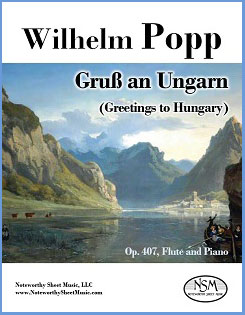 Greetings to Hungary, Op.407, by Wilhelm Popp
Greetings to Hungary, Op.407, by Wilhelm Popp
Flute and Piano
Flute Part and Piano Score, PDF $0.00
Wilhelm Albrecht Otto Popp (1828-1903) was an esteemed German composer, flutist, and pianist. He received his flute training from Caspar Kummer and Louis Drouet, and served as court pianist and flutist at the Ducal Saxon Court Theater in Coburg-Gotha. In 1867 he moved to Hamburg and became first flute of the Hamburg Philharmonic Orchestra. Popp composed some 600 works, many of which were written for flute and piano; most of his compositions were published in his lifetime and were well-known to musicians of his day.
Wilhelm Popp’s Gruß an Ungarn (Greetings to Hungary) was first published for flute and orchestra in 1890, and an edition for flute and piano was published in 1899. NSM re-notated the flute and piano version, changing only the formatting and adding bar numbers and a new cover page. With a decidedly Hungarian sentiment, this piece is great fun to play and provides an enjoyable, exciting listen for audiences as well.
Click for a free download of our re-typeset edition of Popp’s Gruß an Ungarn.
Piano score, 8 pages; Flute part, 5 pages; Total 16 pages.
Reger - Albumblatt - Alto Flute & Piano
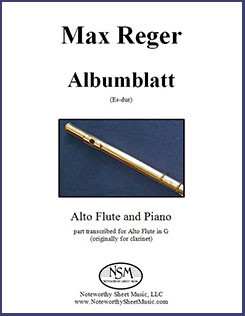 Albumblatt, by Max Reger
Albumblatt, by Max Reger
Transcribed for Alto Flute and Piano by Carol A. Vater
Piano Score and Alto Flute Part, PDF $3.97
This gorgeous and surprisingly complex Albumblatt in E-flat major was written by Max Reger in ~1902 and originally scored for clarinet and piano. The piece is beautifully-suited to the range and sonority of the alto flute, and we provide here both our alto flute transcription of the clarinet part and a re-notated edition of the piano score.
Piano score, 2 pages; Alto Flute part, 1 page; Total, 5 pages.
Reger - Romanze - Alto Flute and Piano
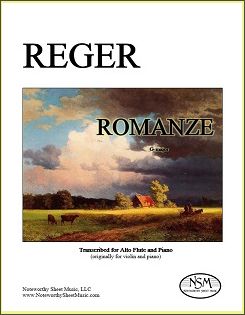 Romanze, by Max Reger
Romanze, by Max Reger
Transcribed for Alto Flute in G and Piano by C.A.Vater
Alto Flute Part and Piano Score, PDF $4.99
Reger's Romanze is a lovely, short piece in G major, consisting of a single movement, Andante con moto. Written in 1902 for violin (or cello) and piano, the work was published by Breitkopf und Härtel ca.1920 and is now in the public domain. Numerous arrangements and transcriptions of the Romanze, including those for C-flute, trumpet, cello, clarinet, viola, or alto saxophone and piano, and even one for oboe and accordion, attest to the piece's popularity. The Romanze works beautifully on alto flute, and Noteworthy Sheet Music's 2016 edition includes both our transcribed alto flute part and a re-notated piano score.
Cover image courtesy of Wikimedia Commons, PD-old: "Bavarian Landscape", by Albert Bierstadt (1830–1902).
Alto Flute Part, 1 page; Score 2 pages; Total, 6 pages.
PreviewReinecke - Lieder - Voice, Violin (Fl/Afl), Piano
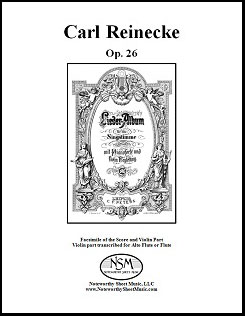 Waldesgruss and Frühlingsblumen, Op.26, by C. Reinecke
Waldesgruss and Frühlingsblumen, Op.26, by C. Reinecke
Facsimile Edition plus Transcriptions for Flute & Alto Flute by C.A.Vater
Score for Violin, Voice, & Piano, Violin Part, Flute & Alto Flute Parts, PDF $9.98
Carl Reinecke (1824-1910) was a renowned German pianist, composer, conductor, and teacher of composition. He composed numerous works, and for over 35 years was a leader of the music scene in Leipzig. Reinecke's Op.26 includes two songs for voice with accompaniment of violin and piano: No.1, Waldesgruss (The Forest's Greeting); and No.2, Frühlingsblumen (Spring Flowers). The vocal range of Reinecke's Op.26 lieder extends from C4 to A5, and thus is well-suited for either soprano or mezzo-soprano.
Our edition contains an "enhanced" facsimile of the original score and violin part, plus new transcriptions of the violin part for either alto flute or flute. Thus, the two songs may be performed utilizing the accompaniment of violin, alto flute, or flute, along with the voice and piano. Alternatively, these pieces work very well as an instrumental arrangement with the voice part played on flute, accompanied by alto flute and piano.
Score, 6 pages; Violin, Alto Flute, and Flute parts, 2 pages each; Total, 18 pages.
PreviewReissiger & Fürstenau - Les Inseparables! - Fl & Pf
 Les Inseparables!, Op.45, by Reissiger & Fürstenau
Les Inseparables!, Op.45, by Reissiger & Fürstenau
Grand Original Duets for Piano and Flute, No.1
Gassett Collection - Facsimile Edition by C.A.Vater/Noteworthy Sheet Music
Flute and Piano Parts, PDF $20.25
Carl Gottlieb Reissiger's Opus 45 was written as a Sonata for Violin and Piano, but was adapted for flute by Anton Bernhard Fürstenau. Fürstenau (1792-1852) composed and arranged many works for flute. He was among the most admired flutists of the 19th century and remains a well-known favorite of flutists today. Reissiger (1798-1859) was an accomplished composer of opera, orchestral, and chamber music. An influential figure in the city of Dresden, he served as Director of the Dresden Opera and later as Kapellmeister. Les Inseparables! No.1, is the first of the Three Grand Original Duets for Piano and Flute by Reissiger and Fürstenau. The piece, which consists of three movements, is a virtuosic work that should delight and challenge both players.
For additional information about the Gassett Collection, please see see our article An Introduction to the Gassett Collection.
Piano part, 21 pages; Flute part, 6 pages; Total, 33 pages.
PreviewReissiger & Sedlatzek - La Pasta - Fl & Pf
 La Pasta! Op.36, by Reissiger & Sedlatzek
La Pasta! Op.36, by Reissiger & Sedlatzek
Concertantes Variations sur la Cavatina de Rossini, No.3
Gassett Collection - Facsimile Edition by C.A.Vater/Noteworthy Sheet Music, with a Foreword by Peter H. Bloom
Flute and Piano Parts, PDF $13.50
Reissiger and Sedlatzek's work La Pasta is a particularly effective concert piece with which the accomplished flutist can enthrall a diverse audience by evoking the dramatic majesty of grand opera while applying the scintillating techniques of the 19th century virtuoso. La Pasta is flutist Johann Sedlatzek's homage, celebration, and souvenir of the redoubtable mezzo-soprano Giuditta Pasta (1798± - 1866±), arranged by the superb composer/conductor Carl Gottlieb Reissiger. Pasta (nee Negri) was a cynosure of Italian opera who created brilliant dramatic roles for Bellini, Donizetti, and Rossini. Legendary Maria Callas (1923-77) is often compared to Pasta by opera aficionados, but few are likely to have heard both in their prime. — P. H. Bloom, 5/23/2011
For additional information about the Gassett Collection, please see see our article An Introduction to the Gassett Collection.
Piano part, 13 pages; Flute part, 5 pages; Total, 24 pages
PreviewRobichaux - Recurrence - Flute & Piano
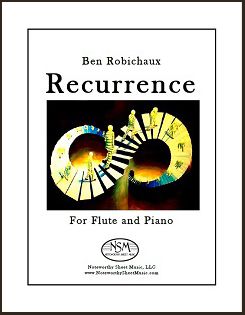 Recurrence, by Ben Robichaux
Recurrence, by Ben Robichaux
Contemporary Composition for Flute and Piano
Flute Part and Piano Score, PDF $12.99
NSM welcomed composer Ben Robichaux as a new contributor to our catalog in early June, 2017, when we published his piece Recurrence for flute and piano. For details of Mr. Robichaux's background, interests, and other works, please click the link to access the Composers section of the NSM website.
Recurrence was written for the composer's friend Michael Lyons. As outlined in the program notes, the "duet is framed in a traditional rondo form: ABACA. The returns of the A theme are never literal returns and repeated materials among the differing sections are never identical repetitions. These returns of A are the inspiration for the title, and the re-occurrence of the A material is a study on the lengths that a theme can be stretched and still be recognizable. The returns undergo extensive development. The B and C sections are meant to be extreme contrasts to the A sections as a means of cleansing the aural palate in order to erase the listener's memory of the theme. Despite the great lengths taken to blur the primary theme, its recognizability is undeniable. The closing section is a reflection on the basic differences among the three occurrences of the main theme. This final section is a summation of the processes that have previously been blurred by the contrasting sections of the piece. Ultimately the form portrays a futile fight that concludes with a peaceful resignation to the inevitable."
![]() The premiere of Recurrence took place in July, 2017, with Kenneth Cox (flute) and Bronwyn Schuman (piano). The performance was recorded by audio engineer Charles Hagaman; a sample can be heard by clicking the mp3 icon.
The premiere of Recurrence took place in July, 2017, with Kenneth Cox (flute) and Bronwyn Schuman (piano). The performance was recorded by audio engineer Charles Hagaman; a sample can be heard by clicking the mp3 icon.
The cover artwork for our publication was created by Scoop Brancisco, used with permission.
Piano score, 10 pages; Flute part, 3 pages; Total, 15 pages.
PreviewSchnauber - Those Infernal Exsanguinators - Flute and Piano
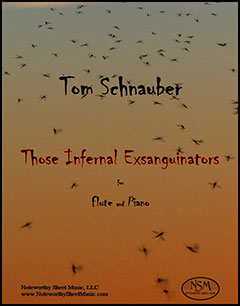 Those Infernal Exsanguinators, by Tom Schnauber
Those Infernal Exsanguinators, by Tom Schnauber
Flute part and Piano score, PDF $17.97
Summer in Minnesota. The sun is setting, the broad sky is clear, and the cool light of dusk promises a welcome respite from the day’s heat and humidity. You step out into the stillness and stand, gazing at the orange-red horizon, thankful for the dimming light and approaching night. And then they come. Those insidious little creatures, those vile insects that define and destroy the season: the mosquitoes. Only some at first, few enough to make you think that if you swat them away, you can still enjoy the evening air. But then more come, and more, and even more. They whine, you moan, they sting, you slap, they swarm, you flail. Soon, your body a mass of swelling welts, you realize that the twilight peace you had hoped for when you left your house is a sham, an impossible illusion shattered by the piercing terror of those infernal exsanguinators. Angry and itching, you run back inside and slam the door shut. —Tom Schnauber
In October, 2020, we at NSM were delighted to welcome Tom Schnauber as one of our contributing contemporary composers; click the link to read about this acclaimed composer's career and his many exciting projects.
Those Infernal Exsanguinators is a compelling piece; to discover this for yourself, please visit Tom Schnauber's soundcloud page and listen to a recording of the work beautifully performed by Tamara Thweatt, flute, and Hey-Seon Choi, piano.
Piano Score, 18 pages; Flute part, 7 pages; Total, 28 pages.
PreviewSchubert - Auf dem Strom - Vo/Cl/Pf
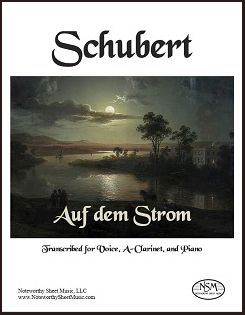 Auf dem Strom, Op.119, by Franz Schubert
Auf dem Strom, Op.119, by Franz Schubert
Obbligato transcribed for A-Clarinet by C. A. Vater
Piano Score and Parts for Voice and A-Clarinet, PDF $9.50
The great Austrian composer Franz Peter Schubert (1797-1828) was a master at creating extremely beautiful, melodic, emotional lieder. His song Auf dem Strom (On the River) provided a musical setting for the text of the eponymous poem written by the German poet and music critic Ludwig Rellstab. The lyrics tell the story of a sad parting, of the yearning and loneliness that sets in as the narrator bids farewell to a loved one on shore, while his river journey carries him away towards the sea. The premier performance of Auf dem Strom took place in Schubert’s 1828 public concert, during which the obbligato part was played by Josef Lewy on horn, the instrument for which the obbligato was written and which undoubtedly can provide an appropriately mournful, sentimental character to the piece. However, an alternate obbligato version for cello was also published. Now, with all respect, we provide an A-clarinet version of the obbligato, in expectation that clarinetists will appreciate this addition to the voice/clarinet/piano repertoire. We believe that a well-played clarinet can aptly contribute a suitably complex, dolorous essence and tone that will adequately do justice to this highly romantic lied by Schubert. Schubert himself created one of his most wonderful and popular works, Der Hirt auf dem Felsen, for clarinet obbligato, and we hope he would welcome our adaptation of Auf dem Strom for A-clarinet.
Score, 19 pages; Voice part, 4 pages; A-Clarinet part, 4 pages; Total, 32 pages.
Preview